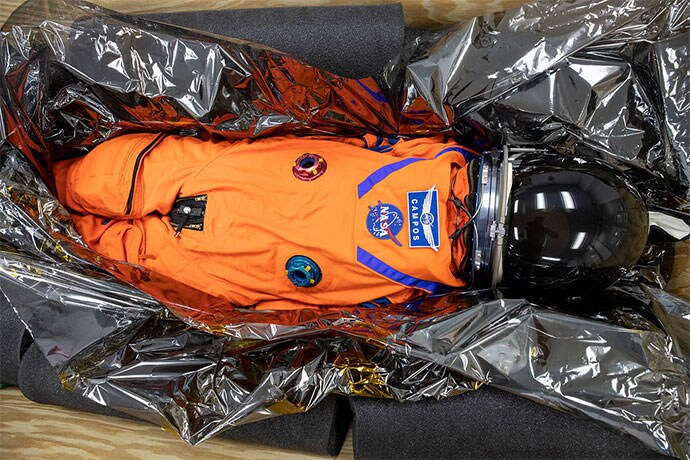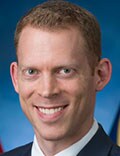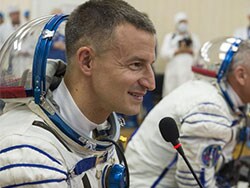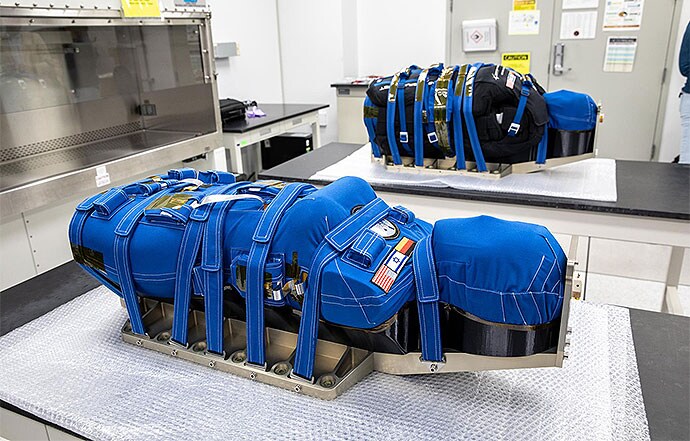Watch Dr Melissa Walton-Shirley's interview with physician-astronaut Frank Rubio aboard the International Space Station.
While at our vacation home in Cocoa Beach, Florida, a sudden low rumble began to rattle the dishes and shake the glass doors. I ran the gamut of sinister etiologies and then realized with a laugh, "It's a rocket launch!"
My husband and I arrived at the beach just in time to see a soaring fiery projectile, the Falcon 9, its cottony white plume twisting and elongating like a vertiginous brush stroke. Within minutes, the sky cleared. As the crowd dispersed, we found ourselves walking alongside our neighbor, who shared the news that he is working on the Artemis project at nearby Kennedy Space Center.

I've been fascinated with space travel since my mom gave me a secondhand Wonder Book, Tom Corbett: A Trip to the Moon.
I knew that an Orion rocket had spent 3 weeks in an unmanned, but not unoccupied, lunar orbit late last year as part of Artemis I, the first in a series of missions that will allow human exploration of the Moon and Mars.

Commander Moonikin Campos, a sensored stand-in for humans on NASA's Artemis I mission.
Phase 3, planned for 2025, will carry Christina Koch and Victor Glover, who would be the first woman and Black astronaut on the Moon, respectively, along with Reid Wiseman and Jeremy Hansen. By 2030, NASA aims to begin a years-long odyssey to Mars — the farthest any astronaut will have traveled.
This led the physician in me to wonder about the health effects of deep-space travel.
Microgravity and the Cardiovascular System
Microgravity wreaks particular havoc on the human heart. Stroke volume and cardiac output increase by 35%-40% with long-duration spaceflight. Left-sided filling pressures and chamber volumes rise while red blood cell density and plasma volume decline by as much as 20%. The interstitium of the upper torso swells due to a massive fluid shift into the thorax, resulting in facial and retinal edema. Leg circumference dwindles, a term known as "chicken legs," accompanied by a puffy face and stuffy nose.

James Pavela, MD
James Pavela, MD, a flight surgeon for NASA, told me by phone that upon return to Earth, astronauts have a slightly lower VO2 max and some loss of exercise capacity that is unrelated to cardiac atrophy. "We do deal with orthostasis after every flight and have employed a robust exercise program to counter it," he said. He described how treadmill settings at the International Space Station (ISS) are changed to foot powering instead of automatic power.
Astronauts also receive IV saline and don graded compression from ankle to stomach once they are back on Earth. I asked about midodrine therapy to counter orthostasis, but NASA found that it interfered with the antiemetics that are always necessary. "Since we started doing fluid boluses on the day of landing, we've not had a clinical or overt episode of syncope," he said, noting that within 6-8 hours of landing, the travelers restart a 2.5-hour daily exercise program.
On board, room for medical supplies is limited, especially within the space capsule. "If we need to lay our stethoscopes on them in a hurry, there are also other obstacles," Pavela said, referring to the bulky space suits and seated position. Proximity to ground control could also interfere with the speed of delivery of acute care.
Astronauts are trained to do basic medical interventions at the ISS, he said. They can use an AED, start an IV, perform CPR, and give intramuscular meds. Additionally, flight surgeons oversee the medical aspects of the mission and are connected to subspecialists on Earth if the need arises. "One thing we do especially well on the operational side is telemedicine using ultrasound and guided echocardiography", Pavela said.
Of course, the best policy is to avoid medical emergencies. Pavela told me that NASA screens astronauts as we would terrestrial humans, but in addition to the traditional ASCVD risk calculator, they also use the Astronaut Cardiovascular Health and Risk Modification Calculator (Astro-CHARM), developed by the National Space Biomedical Research Institute. It includes coronary artery calcium scoring, high-sensitivity C-reactive protein, and the standard CV risk factors.
"I can't recall a single cardiovascular event, even in the retirees, since we started using calcium scoring," Pavela said, noting that most applicants are young and healthy. For established astronauts, "we want them to have a long and productive career, so certainly we prescribe things like statins and antihypertensive therapies."

Andrew Morgan, MD
I also reached out to ISS astronaut Andrew Morgan, an emergency room physician and Army veteran who received the Bronze Star Medal. He described by email that most of the preflight prep is self-directed. "But in flight, we have a daily routine that includes 2 hours of aerobic and resistance exercise," he said. "Our diets are tracked carefully to ensure adequate protein, calorie, vitamin D, and omega-3 intake, which have shown to be effective in maintaining bone mineral density and muscle and body mass."
According to Morgan, astronauts typically return to Earth in the same or better shape, even after 6-12 months on board the ISS.
Thrombus in Space
Despite stringent preventive measures, complications have occurred. A letter in The New England Journal of Medicine described the case of an astronaut with an obstructing left internal jugular thrombus. The astronaut was performing a neck ultrasound on himself as part of a research protocol on fluid dynamics when someone on the ground noticed the abnormality. Because this was the first documented de novo thrombus formation in space, the medical team were uncertain how anticoagulation physiology might be affected.
Fortunately, the ISS payload included 20 vials of enoxaparin. A physician on the ground dosed the astronaut with enoxaparin until oral apixaban could be delivered to the ISS. The direct-acting oral anticoagulant was discontinued 4 days prior to reentry to avoid potential bleeding risks, given the considerable g-forces experienced during splashdown.
After landing, the blood clot disappeared within 24 hours and the astronaut, who had no family history of blood clots, was asymptomatic at 6 months.
Arrhythmias have also occurred. Astronaut James Irwin experienced frequent premature atrial and ventricular contractions during the Apollo 15 mission which were attributed to low potassium, a consequence of massive fluid shifts. And the Russian Mir space station program, conducted from 1986 to 2001, reported a total of 75 arrhythmias and 23 conduction disorders.
There are other concerns. In one study, the increase in carotid artery stiffness after 6 months of ISS residency was roughly equivalent to 10-20 years of normal aging on Earth. The NASA study comparing identical-twin astronauts Mark and Scott Kelly before, during, and after Scott spent a year onboard the ISS found evidence of shortened telomeres that could affect the rate of human aging.
Microgravity also promotes insulin resistance and impaired wound healing. Research studies of pancreatic islets of Langerhans suggest that the pancreas cannot overcome peripheral insulin resistance and amino acid dysregulation during spaceflight.
As the duration of spaceflight increases and astronaut duties become more complex, even a small skin injury could potentially threaten the life of a crew member and the success of a mission. The Suture in Space experiment, led by Monica Monici, scientific manager of ASAcampus, University of Florence, Italy, will study blocks of sutured viable human tissue samples that were sent to the ISS in November 2022.
Radiation Doses and the AstroRad Vest
Deeper-space travel means greater radiation dose exposure. Moonwalkers will experience 5-10 times the radiation exposure of passengers on a transatlantic flight, or 200 times more than folks who keep their feet on the Earth's surface. The daily dose equivalent on the surface of the Moon is more than 2.5 times higher than the dose inside the ISS.

Helga (foreground) and Zohar in the AstroRad vest. Both are equipped with radiation detectors.
To test how to best protect female astronauts against radiation, twin torsos Helga and Zohar, made of materials similar to human tissues, flew on Artemis I. This "small step for mannikin-kind" — on behalf of Duke University, the Israeli Space Agency, and the German Aerospace Center — will analyze the differences between the fully protected Zohar, who wore an AstroRad vest, and Helga, who flew "bare bones."
The third nonhuman occupant of Artemis I was Commander Moonikin Campos. Weighted like a human and wearing a bright-orange Orion Crew Survival system suit, the Commander was strapped into a seat fitted with accelerometers to measure the effects of acceleration and vibration as well as radiation.

Commander Moonikin Campos on board.
These experiments are NASA's first studies of the effects of deep-space radiation on human biology since the Apollo 17 mission in 1972. Many more research projects are ongoing or planned for the Artemis mission.
One day, a low rumble and a sonic boom may again catch this terrestrial cardiologist off-guard, but it will trigger an even deeper appreciation for NASA's programs. Will Earth's positive yield from upcoming space exploration rival the previous developments in MRI-assisted robotic surgery, heart pumps, programmable pacemakers, and telemedicine?
I look forward to 2025 and 2030 when, in place of that fictional little girl from the cover of my Tom Corbett book, a real woman may take her first walk on the lunar surface that will help pioneer a path to Mars. Godspeed to all and prayers for a safe return.
Melissa Walton-Shirley, MD, is a native Kentuckian who retired from full-time invasive cardiology. She enjoys locums work in Montana and is a champion of physician rights and patient safety. In addition to opinion writing, she enjoys spending time with her husband and daughters, and sidelines as a backing vocalist for local rock bands.
Follow Melissa Walton-Shirley on Twitter
Follow theheart.org | Medscape Cardiology on Twitter
Follow Medscape on Facebook, Twitter, Instagram, and YouTube
Credits:
Lead image: NASA.gov
Image 1: Melissa Walton-Shirley, MD
Image 2: NASA.gov
Image 3: NASA.gov
Image 4: NASA.gov
Image 5: NASA.gov
Image 6: NASA.gov
© 2023 WebMD, LLC
Any views expressed above are the author's own and do not necessarily reflect the views of WebMD or Medscape.
Cite this: Human Health in Space: One Small Step for Mannikin-kind - Medscape - May 17, 2023.












Comments